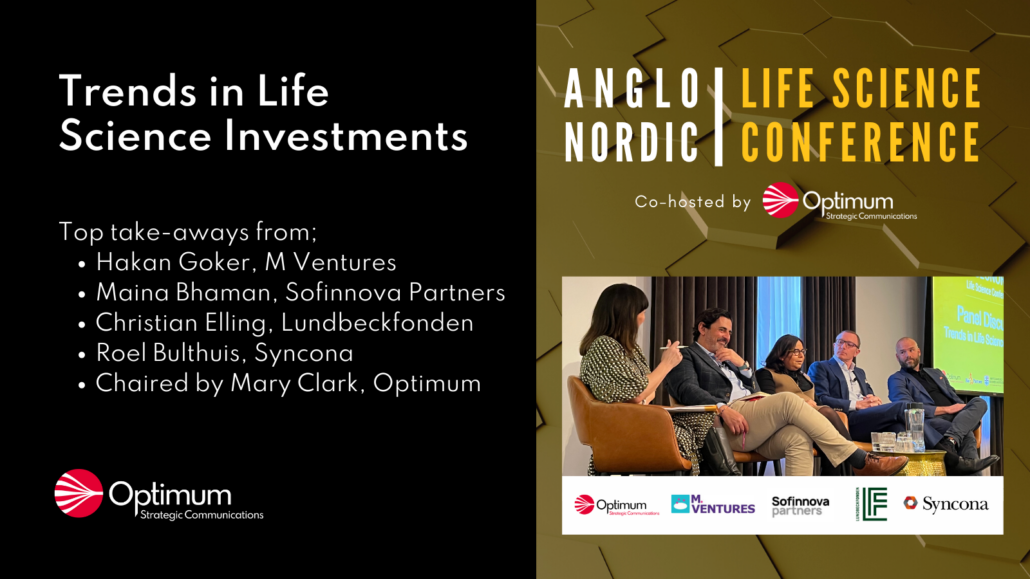Trends in life science investments – Top take-aways from Anglonordic
 The first panel of the day, chaired by Mary Clark, our co-founder and CEO, saw a group of Europe’s leading investors – Hakan Goker, M Ventures; Maina Bhaman, Sofinnova Partners; Christian Elling, Lundbeckfonden; and Roel Bulthuis, Syncona – share sage advice for companies looking to raise funds, providing insights on the most important factors shaping and driving investment in the healthcare sector.
The first panel of the day, chaired by Mary Clark, our co-founder and CEO, saw a group of Europe’s leading investors – Hakan Goker, M Ventures; Maina Bhaman, Sofinnova Partners; Christian Elling, Lundbeckfonden; and Roel Bulthuis, Syncona – share sage advice for companies looking to raise funds, providing insights on the most important factors shaping and driving investment in the healthcare sector.
“It’s not the first time we have seen this”
This panel of veteran VCs have all seen market turbulence before. In fact, they believe that the current climate offers significant opportunities for those with deployable cash, as valuations are low and significant unmet need remains for novel medicines. Granted, companies have “many doors to knock down”, particularly at pre-clinical and early clinical stages, but those who can innovate, manage their cash burn, and have an understanding of how to progress investments, still present attractive propositions.
The audience was reminded of the importance of choosing partners carefully – “look for those who can support the whole 10-15 year journey”. This is particularly relevant in today’s market where the opportunities for an early exit via IPO or M&A are few and far between, making the task of raising capital for late-stage development often as challenging as seed financing, forcing a long-term perspective.
“VCs are choosing to work with people close to home”
The panellists spoke about the scope for attracting international investment. While US and Asian financing was attractive a couple of years ago, VCs are now choosing to co-invest with European funds, as US funds adopt a “wait and see approach”, and Asian funds are choosing not to take the chance in Europe, preferring to work with peers in the East. As markets struggle, investors are choosing to make their move close to home.
“Money is no longer free so manage your costs and cut back early”
Asked how best to survive and thrive in these markets, panellists spoke about the need to strictly manage costs – “cut back early to reach data points in a lean way”. One of the investors spoke passionately about the importance of recognising the value of those performing the research – “when times get tough, companies need to manage the morale of the team, otherwise cost cutting can be a false economy”. Later, they talked about the importance of retaining talent in an increasingly global market since “you can’t patent know-how”.
Investors need to help teams build financeable budgets, while companies must focus on one main programme, rather than multiple, and also recognise the value of small investors in helping them get through inflection points. Notwithstanding specific considerations related to market conditions, there was a pervasive feeling that investors continue to look for the same fundamental things – “companies are built on exceptional science. That has not changed.”
“With every crisis we learn to become better entrepreneurs”
One investor’s view was that the team needs to select the right style of CFO for this market, and led the discussion on to a consideration of the C-suite and the vital role investors play in supporting the management team.
“It is a lonely job”
The Company CEO ought to feel that he/she can rely on active, useful support from those who have been around the block before, with the best investors spending a lot of time with their portfolio’s CEOs, whether they be first time entrepreneurs or individuals who have been through a couple of cycles before.
The panellists did not believe that the market environment should inform the style of person on the Board, rather a company should be looking to build around its core capabilities so that “leadership of companies should extend across market fluctuations”.
“Don’t underestimate the impact of IRA”
The upcoming Inflation Reduction Act (IRA) was raised as a topical and influential factor. While investors have an overriding belief that innovation will continue to drive progress and development, they warned against underestimating the impact that IRA provisions will have on determining business models and targets, prompting a focus on broader indications and/or single molecule development which will “not benefit patients or the industry”. More than one investor felt the topic had not been “properly internalised” yet and needed further processing.
The discussion touched on tensions around the rightful ownership of intellectual property between academic institutions and founders. One investor alluded to upcoming news from tech transfers and VCs that should provide “better guidelines”, pointing to the need for greater transparency, an understanding of the whole ecosystem, and an appreciation that a product or technology is not a static entity.
“Diversify across modalities and indications to build portfolios”
When considering which indication areas are up-and-coming, some of our panellists were at pains to stress their agnostic approach. A range of areas were mentioned, from Oncology and Radiotherapy, to Neurology and Neuroinflammation, with a targeted approach to Cell & Gene Therapies highlighted, and ever greater awareness of the importance of developing new methods for IVF and fertility.
“Know your investors”
Panellists concluded by speaking about the relative benefits of strategic investors versus corporate venture funds, before wrapping up the session by reiterating the importance of choosing the right investment partner. Companies must do their homework and would do well to strongly consider whether an investor is “nice to work with” and “will support them in the long term, based on how they have behaved in the past”.